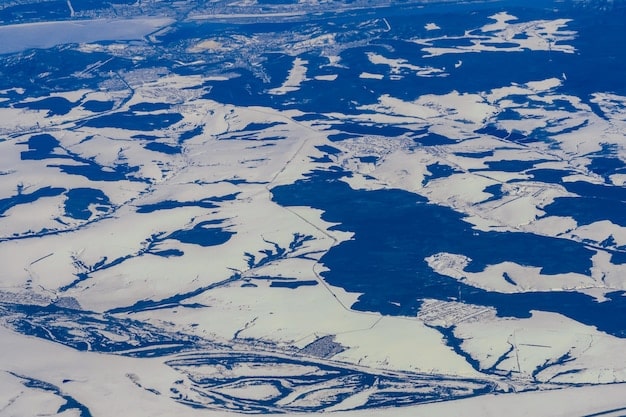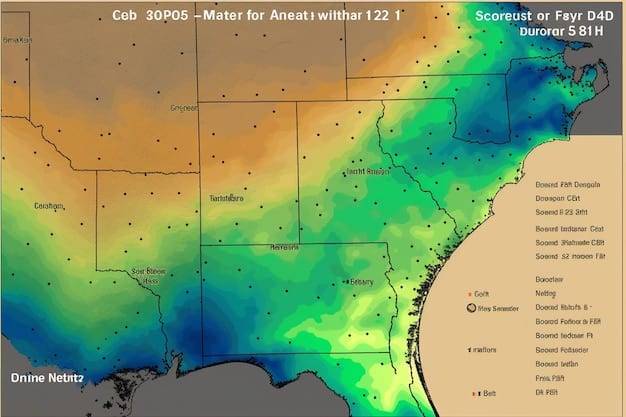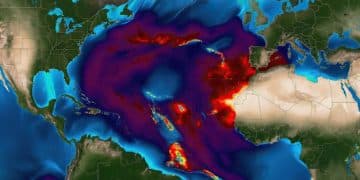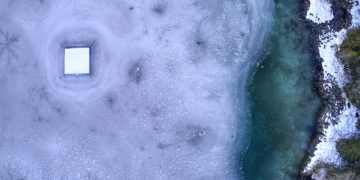Arctic Sea Ice Loss and US Weather: Implications Explored

The accelerating loss of Arctic sea ice profoundly affects US weather patterns by disrupting atmospheric circulation, influencing the polar vortex, and altering jet stream dynamics, leading to more extreme and unpredictable conditions across the United States.
The Arctic, a remote and often overlooked region, plays a far more significant role in our global climate, especially concerning the implications of the current rate of Arctic sea ice loss on US weather patterns. As this critical frozen expanse diminishes at an unprecedented pace, scientists are observing a complex cascade of effects that reach far beyond the poles, directly influencing the severe and unpredictable weather events experienced across the United States. This intricate connection, often dubbed the “Arctic Amplification,” suggests that what happens in the remote north profoundly shapes our daily weather, from blistering heatwaves to crippling blizzards. This article delves into the science behind these transformations, exploring how the shrinking Arctic reshapes atmospheric dynamics and brings new challenges to American communities.
The Disappearing Ice: A Scientific Overview of Arctic Sea Ice Loss
The diminishing extent of Arctic sea ice is one of the most stark indicators of global climate change. Observations over the past few decades reveal a consistent and alarming trend: both the area covered by sea ice and its thickness are rapidly decreasing. This loss is not merely a regional phenomenon; it has global ramifications, fundamentally reshaping the polar environment.
Observed Trends and Satellite Data
Scientific monitoring, largely through satellite imagery, confirms that the Arctic is warming at a rate two to three times faster than the global average. This phenomenon, known as Arctic Amplification, leads directly to accelerated sea ice melt. The most significant losses are typically observed during the late summer months, but winter ice also shows substantial declines.
* Satellite records, which began in 1979, show a consistent decline in Arctic sea ice extent across all seasons.
* The pace of melting has accelerated in recent decades, with several record low minimums reported.
* Older, thicker multi-year ice is being replaced by thinner, more seasonal ice, making it more vulnerable to further melting.
These trends underscore a fundamental shift in the Arctic system. The transition from a predominantly ice-covered ocean to one with increasing areas of open water has profound implications for energy absorption and reflection, which are central to understanding its influence on global weather.
Mechanisms of Sea Ice Melt
The primary mechanism driving sea ice melt is the increase in atmospheric and oceanic temperatures. As the planet warms, less heat is radiated back into space, and a significant portion is absorbed by the oceans, particularly in the Arctic. This absorbed heat then melts the ice from below and around its edges.
* Oceanic heat absorption: Warmer ocean waters melt the ice from beneath, a process exacerbated by increased open water absorbing more solar radiation.
* Atmospheric warming: Higher air temperatures directly melt the ice surface and contribute to warmer ocean temperatures.
* Ice-albedo feedback loop: As ice melts, it exposes darker ocean water, which absorbs more solar radiation instead of reflecting it. This absorbed heat further warms the water and atmosphere, leading to even more melting, creating a powerful positive feedback loop that accelerates the process.
The feedback loop is particularly concerning because it signifies a self-reinforcing cycle that is difficult to reverse. As less ice remains, the ocean absorbs more heat, driving further warming and melt, fundamentally altering the Arctic’s role as the Earth’s “air conditioner.” This altered energy balance at the top of the world then reverberates through atmospheric systems, influencing weather patterns far to the south.
Arctic Amplification and the Jet Stream’s Wobble
The concept of Arctic Amplification is central to understanding how changes in the Arctic impact weather elsewhere. This phenomenon refers to the disproportionate warming of the Arctic region compared to the rest of the planet. While global temperatures have risen by about 1°C since pre-industrial times, parts of the Arctic have warmed by 2-4°C over the same period. This differential warming creates a reduced temperature gradient between the Arctic and mid-latitudes, which has significant implications for atmospheric circulation, particularly the jet stream.
The Science Behind Arctic Amplification
The primary drivers of Arctic Amplification are the rapid loss of sea ice and snow cover. Ice and snow are highly reflective, bouncing sunlight back into space—a phenomenon known as the albedo effect. As these reflective surfaces melt and expose darker ocean water or land, more solar radiation is absorbed, leading to further warming. This feedback loop is a powerful accelerator of Arctic warming.
* Albedo feedback: The reduction of reflective ice and snow exposes darker surfaces that absorb more solar energy.
* Cloud changes: Warmer Arctic temperatures can lead to changes in cloud formation, potentially trapping more heat.
* Ocean heat transport: Warmer ocean currents from lower latitudes are carrying more heat into the Arctic.
This amplified warming reduces the temperature difference between the rapidly heating Arctic and the relatively stable mid-latitudes. This temperature gradient is a key driver of atmospheric circulation, particularly the strength and stability of the polar jet stream.
Impact on the Polar Jet Stream
The polar jet stream is a fast-flowing, narrow air current that circles the Earth, separating colder air to the north from warmer air to the south. It is largely driven by the temperature difference between these two air masses. As Arctic Amplification lessens this temperature gradient, the jet stream’s behavior changes.
A stronger temperature gradient means a more robust and direct jet stream, effectively acting as a boundary that keeps cold Arctic air bottled up in the north. However, as the temperature difference diminishes, the jet stream tends to:
- Become weaker and more wavy: Instead of a strong, relatively straight flow, the jet stream develops larger, more persistent meanders.
- Slow down: The reduced temperature contrast weakens the forces driving the jet stream, causing it to move more slowly.
- Lead to “blocking patterns”: These slower, wavier patterns can lead to atmospheric blocking events, where weather systems become stalled over a particular region for extended periods.
This “wobbly” and stagnant jet stream is a critical link to understanding extreme weather events in the US. When the jet stream becomes more sinusoidal, its troughs can extend much further south, bringing unusually cold Arctic air deep into the United States. Conversely, the ridges can push warm air much further north, leading to unseasonable warmth or heatwaves. The slower movement means these weather patterns can persist for days or even weeks, intensifying their impacts.
Extreme Weather Events Linked to Arctic Changes in the US
The altered behavior of the jet stream, influenced by Arctic Amplification, has been increasingly linked to a range of extreme weather events across the United States. While no single event can be solely attributed to Arctic changes, the emerging scientific consensus points to a clear pattern of increased frequency and intensity of certain phenomena that align with predictions based on a wavier, slower jet stream.
Winter Extremes: Cold Snaps and Snowfall
One of the most counterintuitive, yet scientifically supported, impacts of Arctic sea ice loss on US weather is the potential for more frequent and intense cold snaps. As the jet stream becomes wavier and more prone to deep southward troughs, it can draw frigid Arctic air masses much further into the continental US.
This phenomenon gained significant public attention during events such as:
- The “Polar Vortex” outbreaks: These events, particularly in 2014 and 2019, saw record-breaking cold temperatures extend deep into the Midwest and Northeast, bringing widespread disruptions.
- Increased snowfall in certain regions: While some areas might see reduced snowfall due to warmer temperatures overall, regions on the edge of these deep cold troughs can experience significant snowfall when moist air interacts with the sustained cold. This is particularly true for Great Lakes-effect snow.
These winter extremes are a direct illustration of how a warmer Arctic doesn’t necessarily mean uniformly warmer conditions everywhere. Instead, it can lead to a redistribution of cold air, bringing it to unexpected places with greater persistence.

Summer Extremes: Heatwaves and Droughts
Conversely, the “ridges” in a wavier, slower jet stream can lead to prolonged periods of anomalous warmth and dryness. When a ridge becomes stalled over a particular region, it acts like a heat dome, trapping warm air and inhibiting precipitation.
* Intensified heatwaves: Regions under persistent jet stream ridges can experience longer and more intense heatwaves, leading to increased risk of heat-related illnesses and strained energy grids. The prolonged heat can also exacerbate drought conditions.
* Widespread droughts: Stalled high-pressure systems associated with these ridges can deflect storm systems, leading to reduced precipitation over extended periods. This contributes to and intensifies droughts, impacting agriculture, water resources, and increasing wildfire risk.
* Increased wildfire activity: The combination of prolonged heat and drought creates ideal conditions for wildfires, particularly in the western US, leading to larger, more destructive fires and extended fire seasons.
The persistence associated with a weakened and wobbly jet stream means these weather patterns, whether cold or hot, tend to linger, magnifying their impact. This persistence is a key factor in the increasing intensity of both winter and summer extreme events observed across the US.
Coastal Impacts: Sea Level Rise and Storm Surges
While the direct atmospheric impacts of Arctic sea ice loss on US weather patterns are significant, the broader consequences extend to coastal regions through mechanisms like sea level rise and altered storm dynamics. Although the melting of sea ice itself does not directly contribute to global sea level rise (as it displace water like an ice cube in a glass), the amplified Arctic warming leading to land ice melt (from Greenland and other glaciers) and thermal expansion of seawater are major contributors. These factors, combined with changes in storm behavior, present growing threats to US coastal communities.
Global Sea Level Rise and its Components
Global mean sea level has been rising steadily for decades, and its rate is accelerating. This rise is primarily driven by two factors:
- Thermal expansion: As the ocean warms, seawater expands, taking up more space. This accounts for about one-third of observed sea level rise.
- Melting of land-based ice: The melting of glaciers and ice sheets (primarily Greenland and Antarctica) adds water to the oceans. This is the largest current contributor, accounting for roughly two-thirds of observed sea level rise.
The Arctic’s amplified warming plays a crucial role here, as it accelerates the melt of the Greenland Ice Sheet and Arctic glaciers, directly contributing to the volume of water in the oceans. Even small increases in global sea level significantly impact low-lying coastal areas, increasing the frequency of high-tide flooding and making storm surges more destructive.
Enhanced Storm Surges
Sea level rise amplifies the destructive potential of storm surges. A storm surge is an abnormal rise of water generated by a storm, over and above the predicted astronomical tides. When storms, such as hurricanes or nor’easters, make landfall on an elevated baseline of sea level, the surge can penetrate further inland and cause more extensive flooding.
* Increased inundation: Higher sea levels mean that even minor storms can cause significant coastal flooding.
* Greater reach: Storm surges can reach areas previously unaffected, damaging infrastructure and ecosystems.
* Compounding effects: The combination of high tides, storm surge, and heavy rainfall can overwhelm drainage systems, leading to widespread and prolonged flooding.
Coastal communities from the Gulf Coast to the Northeast are already experiencing more frequent “sunny day” flooding and increased damage from coastal storms. The continued loss of Arctic ice, and its contribution to global sea level rise, ensures that these challenges will intensify, necessitating adaptation measures to protect communities, infrastructure, and economies.
Implications for US Infrastructure and Society
The far-reaching implications of Arctic sea ice loss extend beyond mere weather patterns, posing substantial challenges to US infrastructure, agriculture, human health, and overall societal stability. The increased variability and intensity of extreme weather events demand significant adaptation and resilience strategies.
Infrastructure Vulnerability
US infrastructure, from transportation networks to energy grids, was largely designed based on historical climate norms. The shift towards more frequent and intense extreme weather events, influenced by Arctic changes, exposes significant vulnerabilities.
* Transportation: Roads, bridges, and rail lines are susceptible to damage from extreme heat, flooding, and subsidence due to permafrost thaw (in Alaska). Airports can suffer from heat-related runway issues or be shut down by severe weather.
* Energy grid: Heatwaves increase demand for air conditioning, straining power grids and leading to blackouts. Intense storms can cause widespread power outages, while extreme cold snaps can overwhelm heating systems and lead to natural gas shortages, as seen in Texas.
* Water management: Altered precipitation patterns, including prolonged droughts and intense rainfall, challenge existing water storage and distribution systems. Flooding can contaminate water supplies, while drought can lead to water scarcity.
The costs associated with repairing and upgrading this infrastructure to withstand future extremes are immense, representing a significant economic burden.
Agricultural Impacts
American agriculture is highly sensitive to weather patterns. The increased frequency of heatwaves, droughts, and changes in precipitation patterns directly threatens crop yields and livestock.
* Crop damage: Prolonged droughts can devastate staple crops like corn, wheat, and soybeans, while sudden heavy rains can lead to widespread flooding and crop loss.
* Pest and disease shifts: Warmer winters, influenced by Arctic warming, can allow agricultural pests and diseases to survive in new regions or expand their ranges, increasing challenges for farmers.
* Water scarcity: Regions that rely on snowmelt for irrigation, particularly in the western US, face reduced water availability as snowpack diminishes and melts earlier.
These impacts directly affect global food supplies and prices, creating food security concerns. Farmers face increased uncertainty and economic instability, necessitating significant shifts in agricultural practices and investment in drought-resistant crops and water-efficient irrigation.
Public Health Risks
Extreme weather events also pose direct and indirect threats to public health across the US.
* Heat-related illnesses: Prolonged heatwaves increase the risk of heatstroke, dehydration, and exacerbate existing cardiovascular and respiratory conditions, particularly among vulnerable populations.
* Respiratory issues: Increased wildfires, partly driven by drought conditions, lead to widespread air pollution from smoke, causing respiratory problems for millions.
* Vector-borne diseases: Milder winters can allow disease-carrying vectors like ticks and mosquitoes to survive longer and expand their geographic range, increasing the incidence of Lyme disease, West Nile virus, and other illnesses.
* Mental health impacts: Experiencing and recovering from extreme weather events can lead to significant psychological stress, anxiety, and trauma, particularly for communities repeatedly impacted.
Addressing these public health challenges requires robust public health infrastructure, early warning systems, and community resilience building. The interconnectedness of Arctic changes with US infrastructure, agricultural systems, and public health underscores the pervasive and cascading risks faced by American society, urging a comprehensive approach to climate adaptation and mitigation.
Scientific Debate and Future Projections
While there is a strong scientific consensus that Arctic sea ice loss influences US weather patterns, the precise mechanisms and the extent of their influence remain areas of active research and scientific debate. Advancements in climate modeling and observational data are continuously refining our understanding of these complex teleconnections.
Areas of Ongoing Research and Uncertainty
The primary debate revolves around the strength and consistency of the linkages between Arctic warming and specific weather phenomena in mid-latitudes. Researchers employ various methods, including climate models, statistical analyses of observational data, and atmospheric reanalysis, to study these connections.
* Statistical Significance: Some studies show strong statistical links between Arctic changes and extreme weather, particularly regarding the timing and intensity of cold air outbreaks. Others find weaker or more variable connections, suggesting that other climatic factors might play a larger role in certain events.
* Model Limitations: Climate models are increasingly sophisticated but still struggle to fully capture the nuances of dynamic atmospheric processes and fine-scale interactions. Representing the complex changes in the stratospheric polar vortex and its interaction with the troposphere is particularly challenging.
* Regional Variability: The impacts of a wavier jet stream are not uniform across the US; some regions may experience more profound changes than others, and the precise manifestation of these changes is subject to regional atmospheric dynamics.
The scientific community continues to explore how different aspects of Arctic change—such as sea ice extent, snow cover, and permafrost thaw—individually and collectively contribute to mid-latitude weather variability. The role of other climate phenomena, like the El Niño-Southern Oscillation (ENSO), in modulating these Arctic-driven impacts is also a key area of study.
Projections for Future US Weather Patterns
Despite the ongoing complexities, the general consensus among climate scientists is that as Arctic warming and sea ice loss continue, the likelihood of more persistent and extreme weather events in the US will likely increase.
* Increased persistence of weather patterns: Whether heatwaves, cold snaps, droughts, or heavy precipitation, the trend points towards weather systems becoming ‘stuck’ for longer periods, intensifying their impacts.
* Greater variability and unpredictability: The “wavier” jet stream suggests a future with less predictable seasonal weather, making planning more difficult for agriculture, water management, and disaster preparedness.
* Amalgamation of extremes: The potential for sequential or simultaneous extreme events (e.g., a heatwave followed by a heavy downpour on parched ground) could increase, exacerbating damages.
Future projections heavily rely on the continuation of current emission trends. Aggressive mitigation of greenhouse gas emissions could potentially slow the rate of Arctic warming, buying more time for adaptation. However, given the inertia in the climate system, some level of future impact is already “locked in,” making robust adaptation strategies crucial for the US. The dialogue is evolving from “if” impacts will occur to “how much” and “how often,” urging proactive preparation.
Mitigation and Adaptation Strategies for the US
Addressing the implications of Arctic sea ice loss on US weather patterns requires a dual approach: mitigating the underlying causes of climate change and adapting to the changes that are already inevitable. These strategies involve significant shifts in policy, technology, and societal behavior.
Reducing Greenhouse Gas Emissions
The most fundamental mitigation strategy is to drastically reduce greenhouse gas emissions, primarily carbon dioxide, which are driving global warming and, consequently, Arctic sea ice loss.
This includes:
- Transitioning to renewable energy: Accelerating the shift from fossil fuels to solar, wind, hydro, and geothermal energy sources across all sectors.
- Improving energy efficiency: Implementing policies and technologies that reduce energy consumption in buildings, transportation, and industry.
- Sustainable land use: Promoting forestry, regenerative agriculture, and other practices that enhance carbon sequestration and reduce emissions from land-use change.
International cooperation is paramount, as climate change is a global problem. The US commitment to emission reductions sets an important precedent and contributes to global efforts to stabilize the climate system and slow the rate of Arctic change.
Enhancing Preparedness and Resilience
Given that some climate impacts are already unavoidable, adaptation strategies are crucial for enhancing the US’s preparedness and resilience to extreme weather events.
* Early warning systems: Investing in and improving sophisticated weather forecasting and climate projection systems to provide timely and accurate warnings for extreme events.
* Infrastructure upgrades: “Hardening” existing infrastructure against extreme conditions (e.g., elevating structures in flood zones, reinforcing power grids against high winds and ice, using heat-resistant materials) and designing new infrastructure to withstand future climate impacts.
* Water management strategies: Developing comprehensive water conservation plans, exploring desalination, improving water storage, and implementing flood control measures like permeable surfaces and natural floodplains.
* Public health initiatives: Establishing heat warning systems, cooling centers, and improving emergency response plans for weather-related health crises.
* Agricultural adaptation: Supporting farmers in adopting climate-resilient practices, such as drought-resistant crops, improved irrigation techniques, and diversified farming systems.
Finally, effective adaptation also involves promoting public awareness and education. Engaging communities in understanding climate risks and empowering them to participate in local resilience planning are essential steps. By integrating robust mitigation efforts with thoughtful adaptation strategies, the US can better navigate the complex challenges posed by Arctic sea ice loss and its profound implications for the nation’s weather and society.
| Key Influence | Brief Description |
|---|---|
| 🥶 Jet Stream Wobble | Arctic warming weakens the temperature gradient, making the jet stream wavier and slower, leading to persistent weather patterns. |
| ❄️ Extreme Cold Snaps | Deeper jet stream troughs allow frigid Arctic air to penetrate further south into the US, causing severe cold waves. |
| ☀️ Prolonged Heatwaves | Stalled jet stream ridges create “heat domes” resulting in longer, more intense heatwaves and increased drought conditions. |
| 🌊 Coastal Vulnerability | Arctic warming contributes to land ice melt and sea level rise, amplifying storm surge impacts along US coastlines. |
Frequently Asked Questions
▼
Arctic sea ice loss reduces the temperature difference between the Arctic and mid-latitudes, a phenomenon known as Arctic Amplification. This weakens and makes the polar jet stream more wobbly, allowing cold Arctic air to plunge southward into the US and leading to more persistent heatwaves or droughts due to stalled high-pressure systems.
▼
The polar vortex is a normal circulation of cold air above the poles. Arctic warming can disrupt its stability, causing it to weaken and occasionally split or deform. When this happens, parts of the vortex can extend southward, bringing extreme cold snaps, like those seen in the US in recent years, much further than usual.
▼
Melting sea ice itself doesn’t directly raise global sea levels because it’s already floating in the ocean. However, the Arctic Amplification that causes sea ice melt also accelerates the melting of land-based ice (like the Greenland Ice Sheet and glaciers), which does contribute significantly to global sea level rise, impacting US coastal communities.
▼
While there’s a strong scientific consensus that Arctic warming influences US weather, the precise extent and mechanisms of these connections are still active areas of research. Climate models are constantly being refined, and there’s ongoing debate about the magnitude and statistical significance of these teleconnections for specific regional events. However, the general trend indicates increasing variability.
▼
The US can address these implications through a two-pronged approach: mitigation and adaptation. Mitigation involves drastically reducing greenhouse gas emissions to slow Arctic warming. Adaptation focuses on building resilience to inevitable changes, such as upgrading infrastructure, improving early warning systems, and developing climate-resilient agricultural practices to protect communities.
Conclusion
The relentless pace of Arctic sea ice loss is not an isolated environmental event but a powerful catalyst for profound atmospheric changes that directly influence the weather patterns experienced across the United States. From intensifying heatwaves and crippling droughts to unexpected deep freezes and altered storm trajectories, the scientific evidence increasingly points to a future of greater weather unpredictability. While the exact interplay of forces remains an area of ongoing research, the overarching message is clear: what happens at the Earth’s frozen extremities reverberates globally, demanding a proactive and comprehensive response. Addressing these challenges requires not only a concerted effort to curb greenhouse gas emissions but also robust investment in adaptation strategies to protect American communities and infrastructure from the escalating impacts of a rapidly changing climate.



